PREVIOUS
Highlights of Union Budget 2018-19
March 29 , 2018
2824 days
6518
0
Highlights of Union Budget 2018-19
- - - - - - - - - - - - - - -
- The Union Finance Minister Arun Jaitley on February 1, 2018 presented the Union Budget 2018 in the parliament.
- In the independent India, this will be the 88th budget and the fifth of the NDA Government.
- This year's budget session is crucial as it comes after government's two big financial decisions - demonetisation and the implementation of Goods and Services Tax.
- It will be also NDA government's last full budget presentation (Budget 2018 for the fiscal year 2018-19) before next year's Lok Sabha elections.
- The Budget 2018 has identified various sectors including agriclutre, infrastructure, financial, public services, etc as key drivers of the economy.
- Accordingly, Union Finance Minister Arun Jailtley announced following initiatives:
Economic Health
- Economy firmly on course to achieve high growth of 8%
- Manufacturing, services, and exports are back on good growth path
- GDP growth at 6.3% in the second quarter of 2017-18 signals turnaround of the economy
- Growth in the second half likely to remain between 7.2% to 7.5%
Agriculture and Underprivileged in Rural Economy
- MSP for all unannounced Kharif crops increased by 1.5 times of their production cost like majority of rabi crops.
- Institutional Farm Credit raised to 11 lakh crore in 2018-19 from 8.5 lakh crore in 2014-15.
- Setting up of Fishery and Aquaculture fund and Animal Husbandry fund with total corpus of Rs 10000 crore.
- New scheme Operation Green will be launched for agriculture with corpus of Rs 500 crore.
- 22,000 rural haats to be developed and upgraded into Gramin Agricultural Markets to protect the interests of 86% small and marginal farmers.
- Agri-Market Infrastructure Fund with a corpus of Rs.2000 crore
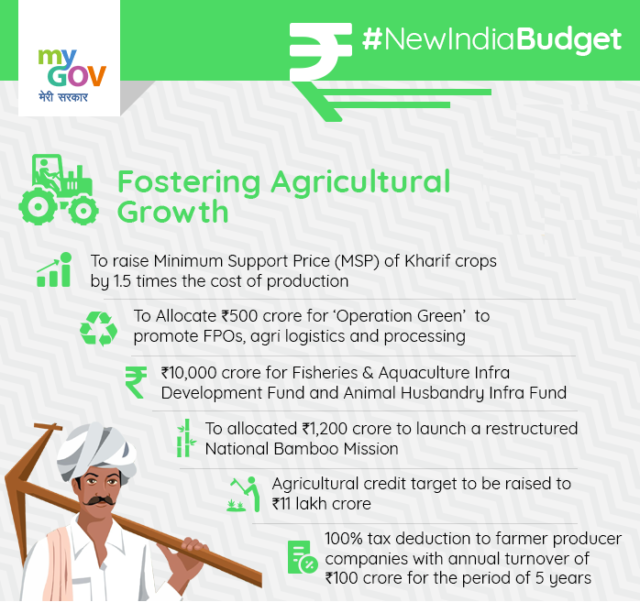
- Allocation for Ministry of Food Processing doubled to Rs.1400 crore
- Loans to Women Self Help Groups will increase to Rs. 75,000 crores in 2019 from 42,500 crores last year.
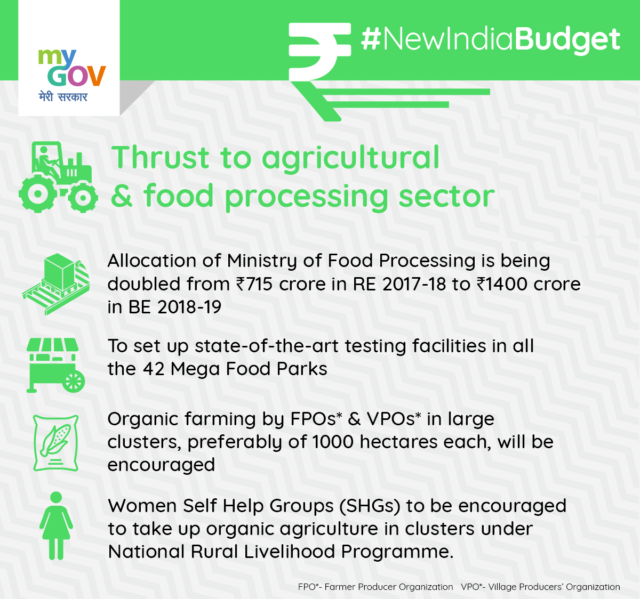
- Allocation of Rs 5750 crore to National Livelihood Mission and Rs 2600 crore to the groundwater irrigation scheme.
- Under Ujjwala Scheme distribution of free LPG connections will be given to 8 crore poor women
- Housing for All by 2022 - more than one crore houses to be built by 2019 in rural areas
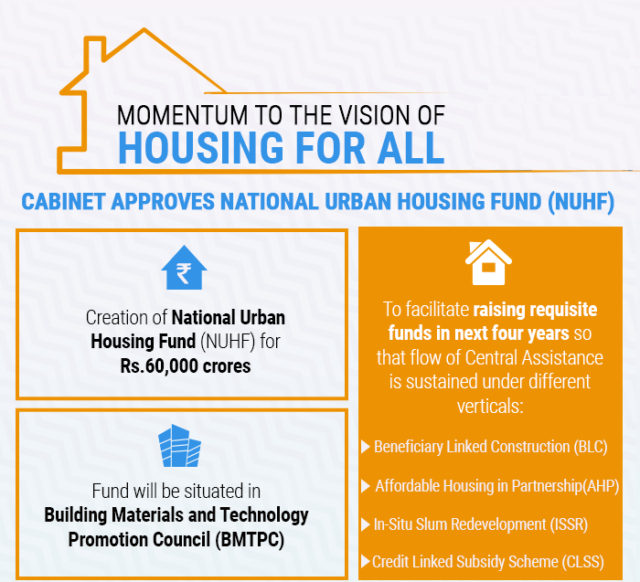
- There are plans for employment of 321 crore person days, 3.17 lakh kilometers of rural roads, 51 lakh new rural houses, 1.88 crore toilets, and 1.75 crore new household electric connections.
Education, Health, and Social Protection
- Budget 2018 proposes to treat education holistically without segmentation from pre-nursery to Class 12.
- Estimated budgetary expenditure on health, education and social protection at Rs.1.38 lakh crore
- An integrated B.Ed programme for teachers has been envisioned for improving quality of teachers and education.
- Gradual progress from blackboard to digital board.
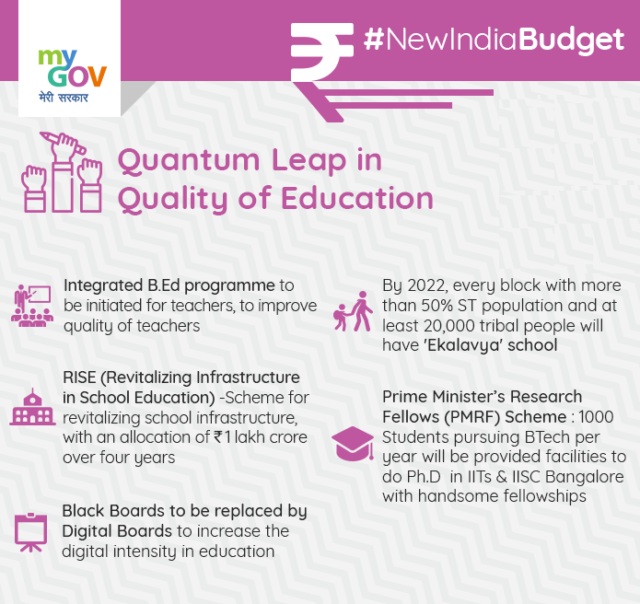
- Revitalising of Infrastructure and Systems of Education (RISE) will be launched by 2019.
- Setting up of two new full-fledged schools of planning and architecture.
- Tribal students to get Ekalavya Residential School in each tribal block by 2022.
- Investments for research & infra in premier educational institutions at Rs.1 lakh crore in next 4 years
- Allocation on National Social Assistance Programme at Rs. 9975 crore
- National Health Protection Scheme, The World’s largest govt. funded health care programme,will be launched to cover 10 crore poor and vulnerable families.
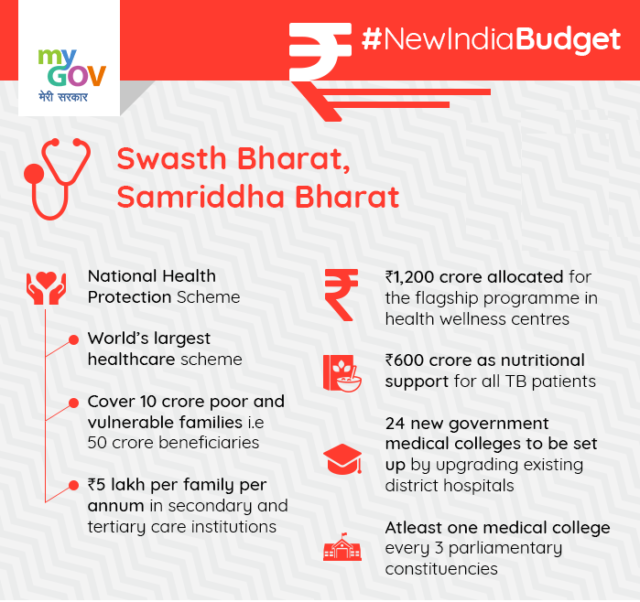
- Under this, up to Rs 5 lakh will be provided to each family per year in secondary and tertiary care institutions. This scheme will have 50 crore beneficiaries.
- Rs 1200 crore for the National Health Policy, 2017.
- Tuberculosis claims more lives every year than any other disease. The government will provide Rs 600 crore as nutritional support to all TB patients.
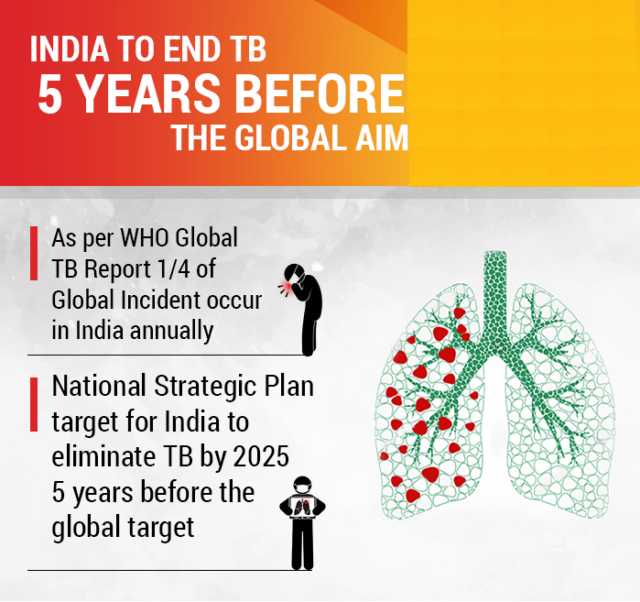
- 24 new government medical colleges will be set up by upgrading existing district hospitals in the country. At least one medical college will be there for three parliamentary constituencies.
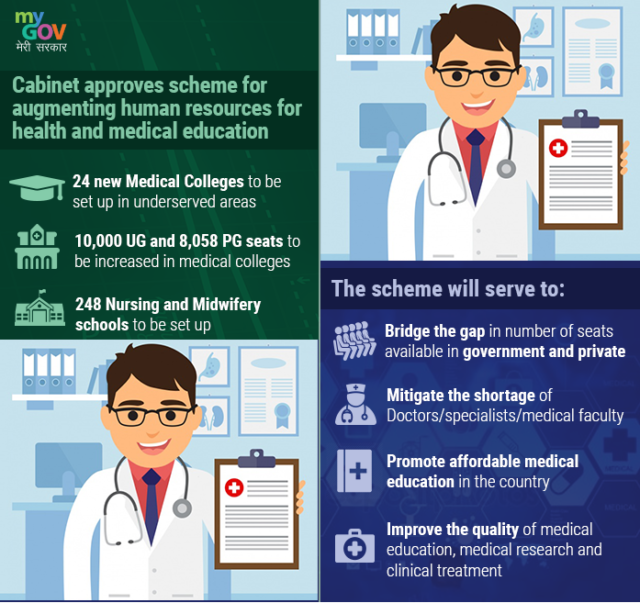
- Clean Ganga: Of 187 projects have been sanctioned, 47 complete
- Banks of Ganga declared open defecation free.
Medium, Small and Micro Enterprises (MSMEs) and Employment
- Major thrust for Medium, Small and Micro Enterprises (MSMEs) – allocation at Rs. 3794 crore
- Rs 3 lakh crore is allocated as target for the Mudra Yojana for the year 2018-19.
- Additonal measures will be taken to boost the growth of venture capital funds and angel investors.
- 70 lakh formal jobs to be created this year
- Govt to make 12% contribution of new employees in the EPF (Employees’ Provident Fund) for all the sectors for 3 years
- Outlay of Rs.7148 crores for the textile sector
- Woman's contribution to the Provident Fund will be reduced to 8 per cent from now onwards for the first 3 years of her employment with no reduction in employer's contribution.
- Increase budgetary allocation on infrastructure for at Rs.5.97 lakh crore
- To develop 10 prominent tourist sites into Iconic Tourism destinations
- 35000 kms road construction in Phase-I at an estimated cost of Rs.5,35,000 crore.
Railways
- Target for capital expenditure for Railways is set at Rs. 1,48,528 crore and a “special railway university” is envisioned at Vadodara, Gujarat.
- 4000 kilometers of electrified railway network slated for commissioning
- Completion of work on Eastern and Western, dedicated freight corridors
- Over 3600 km of track renewal targeted in current fiscal
- Redevelopment of 600 major railway stations
- Mumbai’s local train network to have 90 kilometers of double line tracks at Rs. 11,000 crore cost
- 150 km of additional suburban network planned for Mumbai
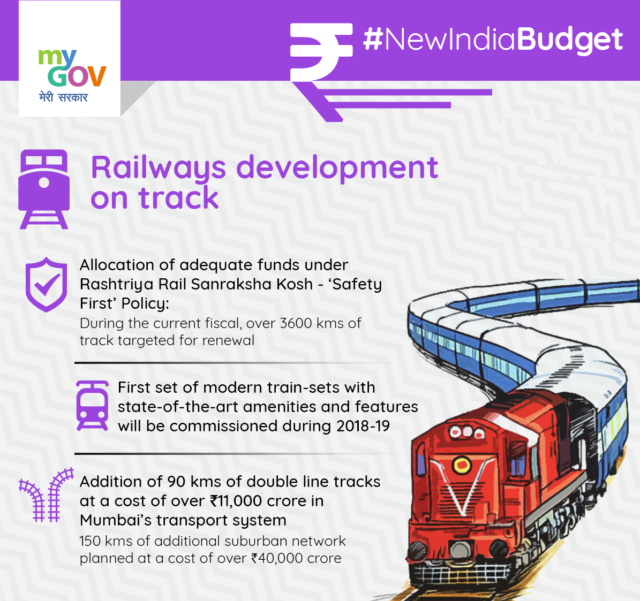
- Suburban network of 160 km for Bengaluru metropolis.
Air Transport
- To expand airport capacity more than five times to handle a billion trips a year
- Regional connectivity - 56 unserved airports and 31 unserved helipads to be connected
- To establish unified authority for regulating all financial services.
Digital Economy
- NITI Aayog to initiate a national program to direct efforts in artificial intelligence
- Department of Science & Technology to launch Mission on Cyber-Physical Systems
- Allocation doubled on Digital India programme to Rs 3073 crore
- To set up 5 lakh wifi hotspots to provide net-connectivity to five crore rural citizens
- 10000 crores for creation and augmentation of telecom infrastructure.
Defence
- The total outlay for defence in budget 2018 is Rs 2.95 lakh crore up from Rs 2.74 lakh crore last year.
- Development of two defence industrial production corridors.
- Emphasis was given on modernisation and enhancement of operational capabilities of the armed forces.
- The intention has been to boost local manufacturing in defence sector but to meet the immediate needs, foreign procurements are made.
- A new industry-friendly defence production policy 2018 for giving a boost to domestic production for private and public sector has also been promised.
Disinvestment & Gold
- Disinvestment target of Rs. 72,500 crore exceeded; expected receipts of Rs.1,00,000 crore
- New disinvestment target of Rs. 80,000 crores for 2018-19
- National Insurance Co. Ltd., United India Assurance Co. Ltd. & Oriental India Insurance Co. Ltd. to be merged into a single entity
- Comprehensive Gold Policy to be formulated to develop gold as an asset class
- To establish a system of consumer-friendly and trade efficient system of regulated gold exchanges in the country
- Gold Monetization Scheme to be revamped to enable people to open a hassle-free Gold Deposit Account.
Emoluments
- 5 lakhs for the President.
- Rs 4 lakhs for the Vice President.
- 3.5 lakh per month to Governor.
- Pay for Members of Parliament - law for automatic revision of emoluments every 5 years.
- 150th Birth Anniversary of Mahatma Gandhi- Rs.150 crores for commemoration programme.
Fiscal Management
- Revised Estimates for Expenditure at Rs.21.57 lakh crore
- Revised Fiscal Deficit estimates at 3.5% of GDP
- To bring down Central Government’s Debt to GDP ratio to 40%
Taxation – Corporate / Personal / Customs Duty
- The total expenditure of the Union government will be Rs 21.57 lakh crore. The projected fiscal deficit of the FY 2018-19 is 3.3 per cent of the GDP.
- No change in personal income tax rates for salaried class.
- Growth of direct taxes in 2016-17 at 12.6 percent & for the financial year 2017-18 (up to 15th January 2018) at 18.7 percent
- Additional revenue collected from personal income tax totals Rs. 90,000 crore
- The number of effective taxpayers increased to 8.27 lakh crore from 6.47 lakh crore in the previous financial year.
- 100% deduction to companies registered as Farmer Producer Companies with an annual turnover up to Rs. 100 crore.
Real estate sector
- Real estate sector - no adjustment to be made for transactions in immovable property where Circle Rate value does not exceed 5% of the consideration
- Reduced Corporate Tax of 25 % extended to companies with turnover up to Rs. 250 crore
- Standard Deduction of Rs. 40,000 in place of the present exemption allowed for transport allowance and reimbursement of miscellaneous medical expenses
- Transport allowance at enhanced rate is proposed to be continued for differently abled persons
- Increase in education and health cess on personal income tax and corporation tax to 4 %
- More concessions for International Financial Services Centre (IFSC), to promote trade in stock exchanges located in IFSC.
- Transfer of derivatives and certain securities by non- residents from capital gains tax, and non-corporate taxpayers operating in IFSC to be charged Alternate Minimum Tax (AMT) at concessional rate of 9 percent at par with Minimum Alternate Tax (MAT) applicable for corporates.
- Payments exceeding Rs.10,000 in cash made by trusts and institutions to be disallowed
- Long-Term Capital Gains (LTCG) to be rationalised
- Proposal to tax Long-Term Capital Gains exceeding Rs.1 lakh at the rate of 10 percent, without allowing any indexation benefit - however, all gains up to 31st January 2018 to be grandfathered
- Proposal to introduce tax on distributed income by equity oriented mutual funds at the rate of 10 percent.
- Customs Duty on mobile phones increased to 20%
- Customs Duty on certain parts of televisions increased to 15 %
Relief to Senior Citizens
- Exemption of interest income on deposits with banks and post offices are proposed to be increased from Rs. 10,000 to Rs. 50,000
- TDS (Tax Deducted at Source) shall not be required to be deducted under section 194A
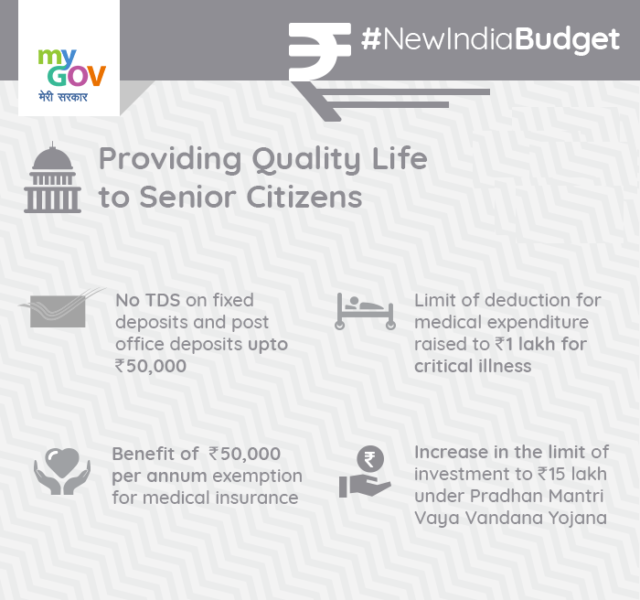
- Benefit will also be available for interest from all fixed deposit schemes and recurring deposit schemes
- Hike in deduction limit for health insurance premium and/ or medical expenditure from Rs. 30,000 to Rs. 50,000 under section 80D.
- Increase in deduction limit for medical expenditure for certain critical illness from Rs. 60,000 (in case of senior citizens) and from Rs. 80,000 (in case of very senior citizens) to Rs. 1 lakh for all senior citizens, under section 80DDB.
- Proposed to extend Pradhan Mantri Vaya Vandana Yojana up to March, 2020. Current investment limit proposed to be increased to Rs. 15 lakhs from the existing limit of Rs. 7.5 lakh per senior citizen.
National Health Protection Scheme
- National Health Protection Scheme (Ayushman Bharat Scheme) will cover 10 crore poor and vulnerable families. Under it, up to Rs 5 lakh insurance cover will be provided to each family per year in secondary and tertiary care institutions. It will have 50 crore beneficiaries. It will be world’s largest government-funded healthcare programme.
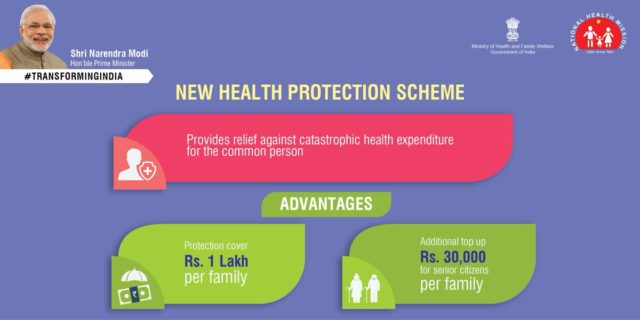
Operation Green
- It will be launched with an allocation of Rs 500 crore on the lines of Operation Flood. It aims to promote farmer producers organisations, processing facilities, agri-logistics and professional management. It also aims to aid farmers and help control and limit erratic fluctuations in the prices of tomatoes, onions and potatoes (TOP). It is essentially price fixation scheme that aims to ensure farmers are given the right price for their produce. The idea behind it is to double the income of farmers by the end of 2022.
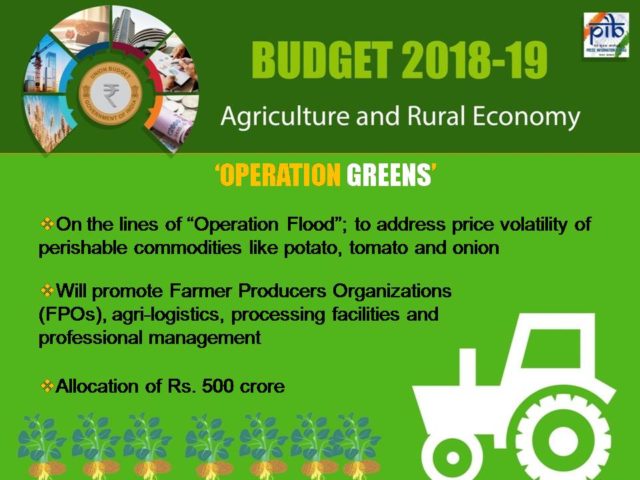
Eklavya School
- Eklavya schools will be established for scheduled caste (SC) and schedule tribe students by 2022 on the lines of Navodaya schools. They will be model residential schools set up in each Block. It will in areas with more than 50% tribal areas and 20,000 tribal people. These schools will be part of Navodaya Vidyalayas. It will provide training in sports and skill development. It has special facilities for preserving local art and culture.
Revitalising Infrastructure and Systems in Education (RISE) Scheme
- RISE scheme aims to lend low-cost funds to government higher educational institutions. It will be launched with a total investment of Rs. 1 lakh crore in the next four years. It will be financed via restructured higher education financing agency (HEFA), a non-banking financial company.
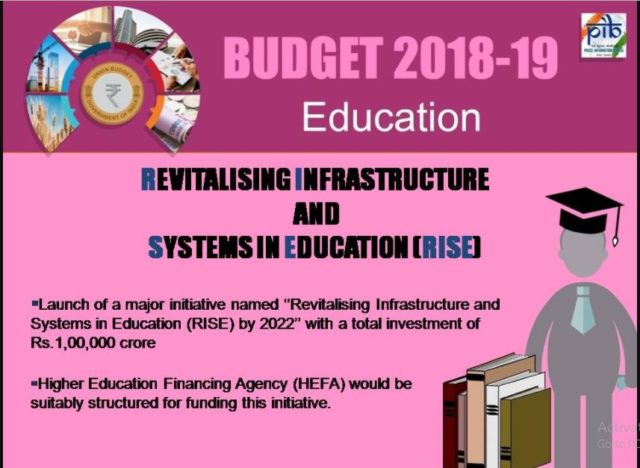
Prime Minister Fellowship Scheme
- It is aimed at facilitating cutting edge research by providing high fellowship amounts to 1000 B. Tech students to pursue PhD in IITs and IISc. Its purpose is to make to produce better research in India and make its institutions climb up in global rankings.
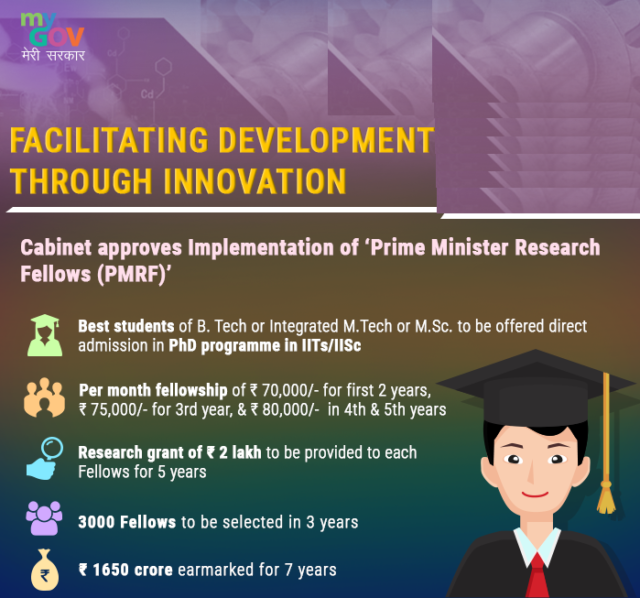
Kisan Credit Card to Fishermen and Cattle owners
- Kisan Credit Card was extended to fishermen and cattle owners. It will enable them to avail the easier loans. It will help people associated with milk production business in rural areas by providing financial assistance and also to fisheries.
Affordable Housing Fund (AHF)
- Affordable Housing Fund (AHF) will be created under National Housing Bank (NHB). It will be funded from priority sector lending shortfall and fully serviced bonds authorised by Central Government. Beyond this, he did not elaborate about the proposed Fund. It will be used to construct one crore households in the rural areas under Pradhanmantri Awas Yojana.
Gobar-Dhan Yojna
- Gobar-Dhan Yojana (also known as Galvanizing Organic Bio-Agro Resource Fund scheme) aims to improve lives of the villagers. Under it, solid waste of dung and fields will be changed into compost, biogas and bio-CNG.

National Bamboo Mission
- 1,290 crore will be allocated under this scheme to help development of bamboo production as an industry in the country. This will help the people of rural and tribal areas.
- - - - - - - - - - - - - - -
Leave a Reply
Your Comment is awaiting moderation.


